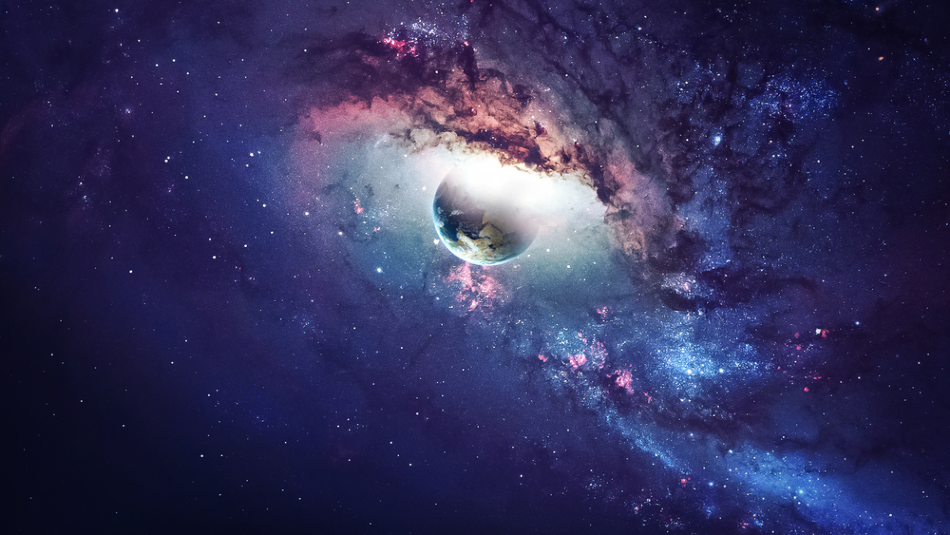
Image Credit: Vadim Sadovski (Elements furnished by NASA)/Shutterstock.com
A massive cavity found in a distant galactic cluster was punched out by the most powerful explosion ever recorded, reveals new research by astronomers.
While studying a distant cluster of galaxies, astronomers have made a staggering discovery of what they describe as the ‘fossilized remains’ of the most powerful explosion ever observed in the universe.
The blast is believed to have originated from a supermassive black hole lurking at the center of a galaxy within the Orpihiuchus cluster — hundreds of light-years from Earth — 240 million years ago.
Such outbursts from galactic centers in active star-forming galaxies — or Active Galactic Nucleus (AGNs) — are nothing new, but what makes this example extraordinary is its sheer power. The explosion, which would have occurred in slow-motion spreading out from the galaxy over hundreds of millions of years, is at least five times more energetic than the next-greatest recorded AGN outburst designated MS0735+64.
The telltale signs of this tremendous outburst within the Orpihiuchus cluster are given by a curious concave gas density ‘bubble’ or cavity within the Intracluster Medium (ICM) that permeates galactic clusters, states a paper published in The Astrophysical Journal.
The outer boundary of this bubble was first discovered as a discontinuity in the cool gas at the center of the cluster using an X-ray image from the Chandra by a separate team of researchers. This team initially considered that it could be the boundary of a bubble inflated by a massive AGN eruption, but discounted that possibility for one predominant reason - the explosion required to create such a massive cavity would have had to have been incredibly large.
The blast that may have caused the cavity in the Orpihiuchus cluster is either an extreme outlier in terms of AGNs outbursts or represents the discovery of an entirely new type of outflow — a new ‘cosmic dinosaur’ as the authors phrase it.
Previous groups of astronomers have studied the region in space but missed signs of the blast as a result of just observing the area in the x-ray region of the electromagnetic spectrum. As this particular cluster is the second brightest in the sky in terms of X-ray emission, it seems like a natural choice to survey it in the high-frequency range of the electromagnetic spectrum. However, this latest discovery was only made when the Orpihiuchus cluster was re-examined for low-frequency radio wave emissions.
The current group of astronomers combined previous x-ray observations with low-frequency surveys conducted in the radio waveband of the electromagnetic spectrum. Granted with an extraordinary level of sensitivity through this gestalt operation, the team discovered that the discontinuity is the boundary of a massive cavity or bubble , and the radio data they found fits inside the X-ray cavity like a ‘hand in a glove.’
The fact that the central AGN now only exhibits emissions in the radio band indicates to astronomers that it must have been significantly more powerful in the past to punch such a large cosmic bubble in the cluster’s ICM.
A Tour of the Biggest Explosion Ever Seen in the Universe
Video Credit: Chandra X-ray Observatory/YouTube.com
The Mystery of the Missing Twin
One of the mysteries that remain around this powerful outburst is what happened to its symmetrical twin. Usually, when AGN outbursts punch out of a galaxy’s central region, they do so in two symmetric jets from each side of the central axis. This creates two lobes in the surrounding ICM.
In current observations, there only appears to be the aftermath of one side of this twin jet and only one lobe is visible. There are a few reasons why this could be the case posited by the paper.
Firstly, the AGN’s mirror-image counterpart burst could have propagated into a less-dense Intracluster medium on one side of the galaxy. With less material to clear, this would have resulted in the jet spreading much further, thinly dispersing and eventually dissipating altogether. Alternatively, the motion of the galactic cluster could have helped ‘smear out’ traces of the outburst.
In many ways, the team’s operations are analogous to archelogy, albeit on a cosmic scale. The x-ray observations cleared the topsoil, while the radio observations allowed them to delve deep in the ground and discover their remarkable fossilized cavity.
If the burst that cleared this cavity over 240 million years ago is an example of a new type of AGN or one emitted by an undiscovered source, developments in telescope technology may unearth more fossilized remains very soon.
The team used a combination of four telescopes , including the space-based pairing of NASA’s Chandra X-ray Observatory, ESA’s XMM-Newton, the Murchison Widefield Array, and the Giant Metrewave Radio Telescope. The latter two are located in Australia and India, respectively.
This effort constituted 2,048 antennas, which honed in on the Orpihiuchus cluster. The team will soon be able to search for such massive explosions with 4,096 antennas, promising ten-times the sensitivity.
Perhaps we can discover, just as fossils here on Earth pointed us towards the behemoths that once ruled our landscape, an age of the universe when it was dominated by explosions and outbursts analogous to massive cosmic titans.
There is no doubt that the newly discovered AGN outburst in the Ophiuchus Galaxy Cluster currently holds the title of the ‘biggest explosion ever recorded.’ How long it can hold on to it is another matter altogether.
References and Further Reading
Giancintucci. S, Markevitch. M, Johnson-Holliet. M, et al, Discovery of a giant radio fossil in the Ophiuchus Galaxy Cluster, The Astrophysical Journal, (2020). https://iopscience.iop.org/article/10.3847/1538-4357/ab6a9d
Disclaimer: The views expressed here are those of the author expressed in their private capacity and do not necessarily represent the views of AZoM.com Limited T/A AZoNetwork the owner and operator of this website. This disclaimer forms part of the Terms and conditions of use of this website.